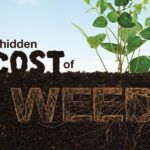Urban Students Prepare for Careers in Agriculture
An agricultural high school in Chicago equips students with the skills they need to succeed in the industry.

Imagine a high school where classrooms connect to a barn with goats, students care for alpacas, and cows graze in the distance. You’re probably picturing a rural community, but this school is in one of the most populous cities in the country: Chicago.
“What we’re learning here is so important for the agriculture industry,” says senior Zachary Gonzalez-Murillo. “Not a lot of kids know what agriculture is.”
The Chicago High School for Agricultural Sciences is a magnet high school within the Chicago Public Schools system. In addition to typical high school curricula, students graduate from this high school with technological skills and agricultural knowledge. This gives them a major step up in college and beyond, says Robin Thomas, early talent and university relations manager with Syngenta.
An Urban Oasis
Despite the urban setting, the school sits on 73 acres of land — 32 of which are filled with livestock, beehives and a market garden that produces a variety of crops, including sweet corn, peppers, squash and pumpkins. As part of their curriculum, students tend to the animals, manage crops, and take that harvest to the school’s farmstand — where they sell it to the community.
“In their last two years, students have mini majors where they’re placed into one of seven agricultural pathways,” says Noelle Coronado, lead agriculture teacher and FFA chapter advisor at the ag sciences school. “Everything they’re doing in these ag classes has an instructional portion and a hands-on project. And all their projects benefit the school, its animals and crops, and the local community.”
Following their sophomore year, students rank their top pathway choices, which include animal science, agricultural mechanics and technology, biotechnology in agriculture, agricultural finance and economics, horticulture and landscape design, food science, and natural resources and environmental management.
Connecting the Dots
As a senior in the animal science pathway, one of Kaili Norwood’s biggest responsibilities is caring for the school’s three alpacas. Norwood arrives each morning to check the animals’ food and water and ensure their home is clean. Alpacas Mikey, Gunner and Tina each have distinct personalities and play a key role in the agricultural environment of the school.
“Right now, some of the students are working to turn the alpacas’ stool into fertilizer that is then used in the market garden to help the soil, because it has great nutrients for the crops,” says Norwood. “I’d never thought about how animal science is agriculture before, but now I definitely get to see how it’s all tied together.”
Many of the pathways overlap in ways the students didn’t consider before attending the school.
Everything they’re doing in these ag classes has an instructional portion and a hands-on project. And all their projects benefit the school, its animals and crops, and the local community.
“Our agricultural finance students are in charge of managing many aspects of the farmstand,” says Coronado. “The stand opens after the school day ends and, on most Saturdays, our students are the ones helping in the shop, selling the products and learning how to successfully manage a real business.”
The farmstand, connected to the barn, serves as a place for students to sell the products they’ve been creating in the hands-on portion of their classes. Beyond food, the nearby community visits the farmstand for its farm-to-market products that include soy candles, zucchini bread, goat milk lotion and yarn spun from the alpacas’ wool.
“We’re getting to see what problems farmers face and where the money they spend on their farm goes, including to crop protection and general management of their farms,” says Gonzalez-Murillo, who is in the agricultural finance and economics pathway.
A Lasting Impact
Teachers at the school believe the students will apply what they’re learning to life after graduation, and many do continue on to higher education programs and careers in ag.
“We’re grooming the next generation of farmers,” says Brittney Kee, horticulture science teacher. “We have budding agronomists, soil scientists and greenhouse producers. I have a lot of kids that are really into urban farming, so they like vertical gardening. We’re getting more and more students excited and passionate about agriculture.”
Alumni contributions demonstrate the lasting impact the high school has on students. A former student donated the school’s most recent addition to its alpaca family, and many of the teachers remain in contact with former students who work in the industry. Additionally, seven of the 10 staff in the agriculture department are alumni themselves. They wanted to give back to a place that was so formative in their youth.
“My life-long mentor still works at the school and is a huge reason for my career change that led me back here as an educator after graduating over 10 years earlier,” says Coronado. “I don’t think I would ever want to leave this position. I love watching students have these light bulb moments about how much agriculture plays a key role in their day-to-day lives, and I see them learning how to speak articulately about the industry.”
Moving Forward
Schools like this one help students prepare for careers by providing them with networking and internship opportunities that many high school students typically don’t receive. All the school’s students are members of their FFA chapter, attend a two-week summer education program after their sophomore year, and can apply for a paid summer internship prior to their junior and senior years.
When it comes to applying for college-level internships or an entry-level position at a company like Syngenta, these activities help them stand out from their competition.
“When I’m talking to college students about their resumes, I always recommend they leave high school activities like their FFA and 4-H leadership positions on there until they graduate,” Thomas says. “That kind of experience, especially at a unique school with a diverse background, shows us that they’ve already acquired a lot of the skills that will help them in their career.”
Their agricultural involvement goes above and beyond the extracurricular activities of FFA. Students participate in agricultural activities during all four years of high school through their curriculum, annual career fairs with ag professionals and internships that provide an outlet to apply what they’re learning to real situations. They also bring an urban voice to a traditionally rural field, which brings new perspectives and ideas to the industry.
Not all students who attend the Chicago High School for Agricultural Sciences end up with a career in agriculture, says Coronado, but all gain understanding of its importance and how they can be better stewards of the land, their food and the industry that keeps the world moving.
4 Min Read
- Chicago High School for Agricultural Studies gives agricultural training to urban students.
- High school ag knowledge provides a leg up in career searches.
- Students learn everything from raising livestock to agribusiness.
More Articles About Community & Culture
4 Min Read























